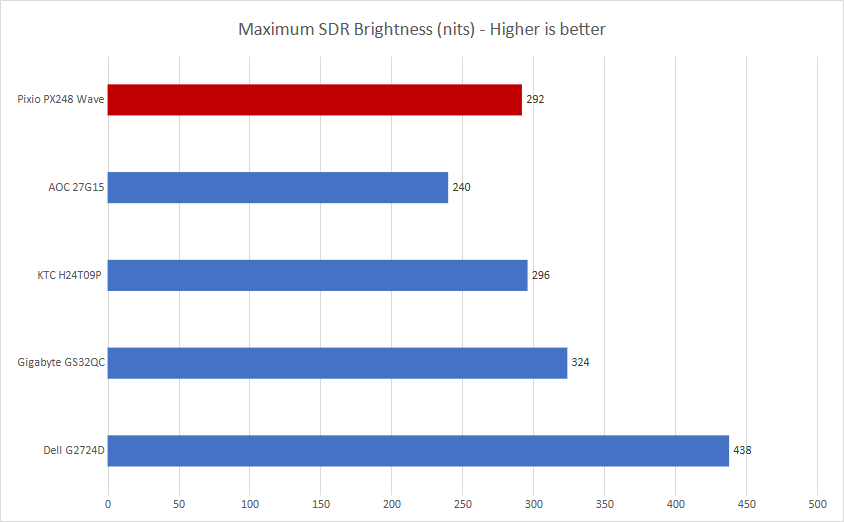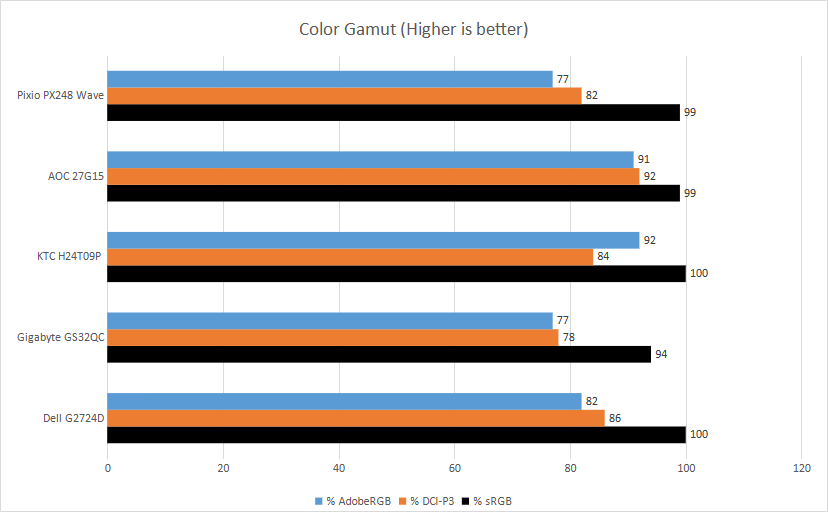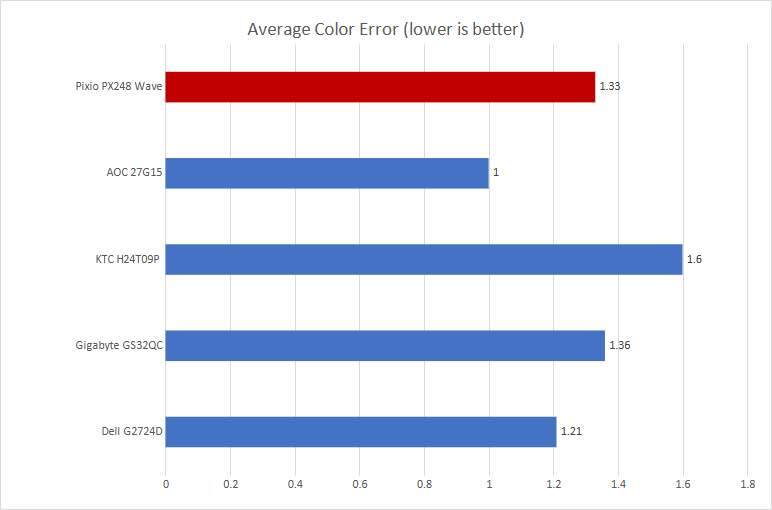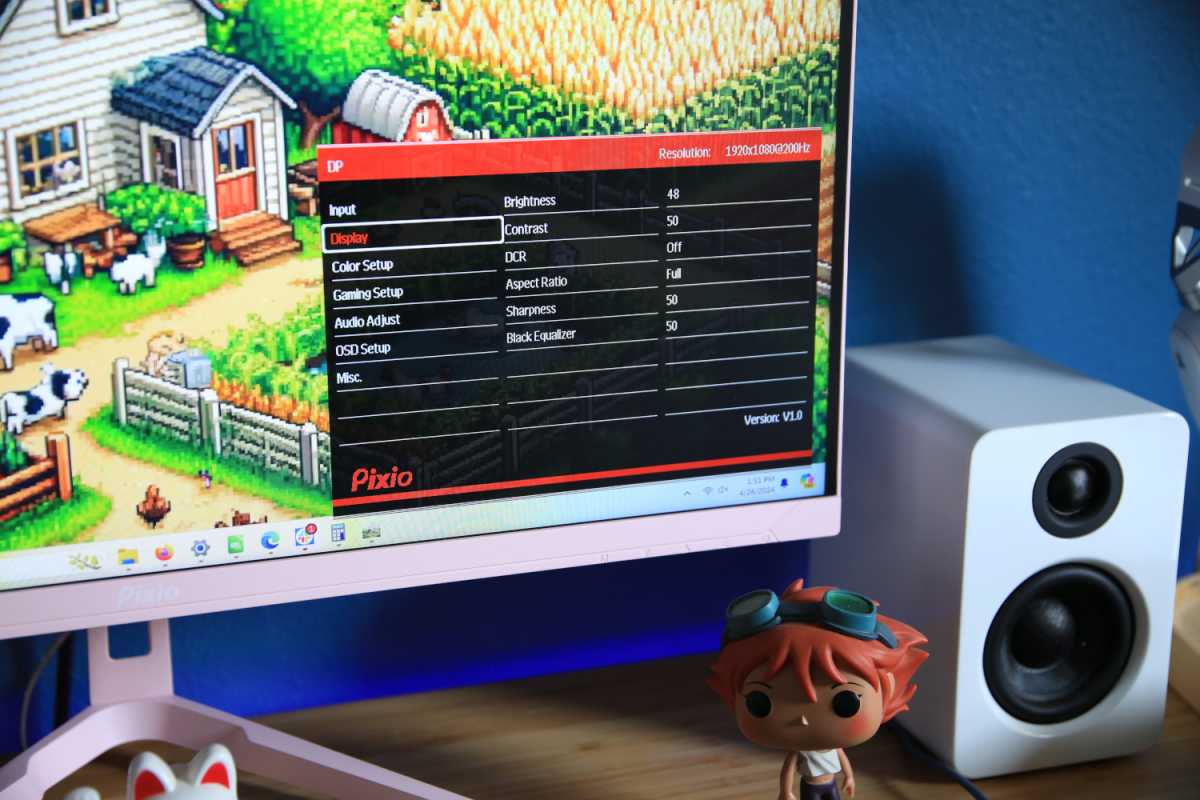At a glance
Expert's Rating
Pros
The Pixio PX248 Wave is an affordable monitor with good motion clarity and design that’s perfect for gamers who want a unique look.
Best Prices Today: Pixio PX248 Wave
Retailer
Price
Pixio
$139.99
View Deal
Price comparison from over 24,000 stores worldwide
Product
Price
Price comparison from Backmarket
Let’s be real: Most gaming monitors are rather boring, and those that aren’t tend to lean towards an edgy, masculine, or cyberpunk look. The few that bucks the trend, like Alienware’s retro sci-fi aesthetic, are usually expensive. Pixio’s PX248 Wave offers an affordable alternative to the status quo, and backs up its looks with good motion clarity.
Pixio PX248 Wave specs and features
The Pixio PX248 Wave’s basic specifications are typical for any budget monitor. It has a 24-inch IPS display panel with a resolution of 1920×1080. The monitor offers HDMI and DisplayPort input and supports Adaptive Sync.
Two specifications stand out, however. The monitor has a 200Hz refresh rate, which, though not the highest available for $150, is certainly towards the upper limit of what gamers can buy on a budget. It also has a pair of 3-watt speakers that are stronger than most of its peers.
What really stands out, however, is something that doesn’t translate easily to a spec sheet: the looks.
Further reading: See our roundup of the best gaming monitors to learn about competing products.
Pixio PX248 Wave design
The experience delivered by the Pixio PX248 Wave depends on the colorway that you purchase. Four colors are available: Black, White, Pink, and Blue. I received the Pink colorway, which is a rare option for any gaming peripheral and especially for a monitor.
And you know what? It looks great. Pixio opts for a cozy, pastel shade of pink that is a perfect fit for anyone looking to create a lighter, more inviting atmosphere for their gaming den.
Of course, going for a more basic colorway like Black will lessen the impact of the design, but Pixio’s build quality is good for the price. Plastic is the material of choice, but I noticed virtually zero flex while handling the monitor, and the design doesn’t scream “budget” to all who look. You could spend twice as much and not buy any noticeable gain in build quality.
Ergonomics is where Pixio makes some cuts. The monitor has a simple tripod-style stand that clips to the back of the monitor and only adjusts for tilt. A VESA mount is included for use with third-party monitor arms and stands but uses the less popular 75x75mm bolt pattern instead of the more standard 100x100mm pattern. The 100mm pattern is also supported with an adapter, which can be finicky.
Those looking to complete the look of the PX248 Wave’s pink, blue, and white colorways should consider the Pixio PS1S Wave monitor arm. I didn’t get a chance to test it, so I can’t vouch for its quality, but it’s built to color-match the PX248 Wave monitor.
The Pixio PX248 Wave is a gift to gamers who must stick to a strict budget.

The back of the The Pixio PX248 Wave, in Pink.
The back of the The Pixio PX248 Wave, in Pink.
Matthew Smith / Foundry
The back of the The Pixio PX248 Wave, in Pink.
Matthew Smith / Foundry
Matthew Smith / Foundry
Pixio PX248 Wave connectivity and menus
The Pixio PX248 Wave’s connectivity is limited even for a budget monitor. It has just two video inputs: one HDMI 2.0 and one DisplayPort 1.4. Both inputs support the monitor’s maximum refresh rate of 200Hz, which is nice to see on a budget monitor. However, most competitors offer three video inputs.
Pixio also includes a 3.5mm audio jack for audio pass-through to a headset and a single USB-A port. However, the USB-A port is only meant for use with firmware updates, and indeed, I could find no other purpose for the port.
The monitor’s options are selected by navigating through the on-screen menu with buttons located on the lower-right lip. These are more cumbersome to use than the joystick-style controls that are common on many monitors. Pixio’s menu is easy to navigate, at least, and offers a fair range of options, including adjustments for gamma, color temperature, hue, and saturation.
A pair of 3-watt speakers are included, and they’re a pleasant surprise. There’s enough volume to be usable and mostly avoid sounding muddy, which is important when listening to music and playing games. There’s even some dynamism in the sound stage that provides a sense of depth that’s uncommon for built-in speakers. Dedicated external speakers will be an upgrade, but I could get by with the bundled speakers in a pinch.
Pixio PX248 Wave SDR image quality
Image quality can be dicey with a budget gaming monitor, but has improved in recent years. The Pixio PX248 Wave reinforces that trend with solid color performance and a decent contrast ratio, though it also has a few flaws.

Matthew Smith / Foundry
Matthew Smith / Foundry
Matthew Smith / Foundry
The monitor’s brightness tops out at about 292 nits, which, though not bad, is towards the low end of what I would expect from a modern monitor with an IPS display panel. This level of brightness is enough to be usable in most situations, but brightly lit rooms may begin to overwhelm the display and make it appear dim.

Matthew Smith / Foundry
Matthew Smith / Foundry
Matthew Smith / Foundry
I measured a maximum contrast ratio of 1050:1. That’s hardly a record-setting result; in fact, it is towards the low end of what is available from modern gaming monitors. Still, the contrast ratio is acceptable for the price and high enough to hold up in some situations.
The PX248 Wave suffers when displaying dark games in a dark room, as it lacks the deep blacks and shadow detail needed to provide a convincing representation. It’s at its best when displaying bright, colorful content in a well-lit room, as this helps obscure the monitor’s problems with darker content.
As the graph shows, there’s a major gap between monitors that have an IPS panel, like the PX248 Wave, and those that have a VA panel, like the AOC 27G15. That might lead you to think a VA panel is better, but budget VA panels tend to have problems with sharpness, so there’s no perfect choice. Gamers have to decide if more realistic contrast or a sharper image is preferable.

Matthew Smith / Foundry
Matthew Smith / Foundry
Matthew Smith / Foundry
The PX248 Wave’s color gamut comes in at 99 percent of the sRGB gamut, 82 percent of DCI-P3, and 77 percent of AdobeRGB. This again is a long way from the best performance available but is fine for the price. It lacks the rich and saturated look that is available from monitors with a wider color gamut, but it still has enough range to hold some allure.

Matthew Smith / Foundry
Matthew Smith / Foundry
Matthew Smith / Foundry
Color accuracy, on the other hand, requires no excuses or caveats. The monitor’s out-of-box color accuracy is good, and though I wouldn’t recommend it for professional photographers, it’s fine for editing family photos or uploading an occasional video to YouTube. It’s difficult to find better color accuracy for the price.
However, the monitor does have issues with one aspect of color, and that’s color temperature. The measured out-of-box color temperature is 8500K, which is way off the intended target of 6500K. Simply put, the monitor’s color looks far too cool and sterile. The color temperature adjustments provided by the monitor can improve this, but the color temperature remained above 6500K even when set to the “Warm” preset. Gamma was slightly off, producing a gamma result of 2.1 when it should be at a result of 2.2, but this was far less noticeable.
Sharpness is acceptable. A resolution of 1920×1080 is not going to impress most shoppers in 2024, but on a 24-inch monitor, it provides an acceptable pixel density of 92 pixels per inch. As you might expect, the PX248 Wave looks sharper than a 27-inch 1080p or 32-inch 1080p display. Small fonts can look jagged when browsing the web, but sharpness issues are less noticeable in games, especially those with a quality anti-aliasing implementation.
On the whole, the Pixio PX248 Wave’s image quality performance is what I would expect from a budget gaming monitor. It has some strengths, such as its sharpness and color accuracy, but also weaknesses, such as the unusually cool color temperature.

Pixio PX248 Wave
menu.
Pixio PX248 Wave
menu.
Matthew Smith / Foundry
Pixio PX248 Wave
menu.
Matthew Smith / Foundry
Matthew Smith / Foundry
Pixio PX248 Wave HDR image quality
The Pixio PX248 Wave provides support for HDR but, like any budget monitor, it’s not a great choice for HDR content. It lacks the brightness, contrast, and color gamut required to do HDR justice, so it does little to improve image quality over SDR. The same is true of the monitor’s competition, however, so the PX248 Wave is at no disadvantage here.
Pixio PX248 Wave motion performance
Refresh rate is among the Pixio PX248 Wave’s most alluring features. It offers a maximum refresh rate of up to 200Hz, which is exceptional for a monitor that retails at $150. It also provides Adaptive Sync that should function with both Nvidia and AMD video cards. FreeSync worked without issue when the monitor was connected to my Radeon RX 7800 video card.
Motion clarity at 200Hz is solid, but not amazing. Scrolling tests from League of Legends and DOTA 2 showed that character silhouettes and spell effects were easy to make out, but hitpoint bars and character names were still difficult to read. Motion clarity holds up better when panning the camera in 3D games, as significant detail is retained in distant objects and fine textures.
The monitor’s decent out-of-box motion clarity can be improved with MPRT, a feature that reduces motion blur by strobing the backlight at an extremely high frequency. It also has several improved response time modes that increase the speed at which pixels respond to changes.
These modes introduce noticeable visual artifacts. MRPT adds a slight “double image” effect behind moving objects and disables Adaptive Sync, while bumping up the response time results in an over-sharpened look.
However, the features are undeniably effective at reducing motion blur. I think the MRPT mode, in combination with the Medium response time mode, will be appealing to competitive gamers on a tight budget. It delivers motion clarity close to what I’ve witnessed on a 360Hz display. If you’re not interested in competitive games, however, I’d recommend leaving both features off.
Should you buy the Pixio PX248 Wave?
The Pixio PX248 Wave is a great choice for gamers who want attractive design and solid motion clarity in an extremely inexpensive monitor. Priced at just $150, the PX248 Wave is affordable for a monitor with a refresh rate above 144Hz, yet it also provides several unusual colorways that will fit a variety of gaming setups. Strong audio performance from the built-in speakers add icing to the cake.
Image quality is a mixed bag, however, due to issues with color temperature and mediocre contrast. And the PX248 Wave, like most gaming monitors below $200, faces pressure from low-to-mid-range alternatives like the Dell 2724D, which typically costs $50 more but defeats the PX248 Wave by every metric. Even so, gamers that must stick to a budget of $150 should give the Pixio PX248 Wave a look.
Monitors
Expert's Rating
Pros
- Attractive design, especially in unique colorways
- Built-in speakers are surprisingly decent
- Solid color accuracy and respectable gamut
- Good motion clarity
- Built-in stand only adjusts for tilt
- Just two video inputs
- Awkward menu controls
- Color temperature skews cool
The Pixio PX248 Wave is an affordable monitor with good motion clarity and design that’s perfect for gamers who want a unique look.
Best Prices Today: Pixio PX248 Wave
Retailer
Price
Pixio
$139.99
View Deal
Price comparison from over 24,000 stores worldwide
Product
Price
Price comparison from Backmarket
Let’s be real: Most gaming monitors are rather boring, and those that aren’t tend to lean towards an edgy, masculine, or cyberpunk look. The few that bucks the trend, like Alienware’s retro sci-fi aesthetic, are usually expensive. Pixio’s PX248 Wave offers an affordable alternative to the status quo, and backs up its looks with good motion clarity.
Pixio PX248 Wave specs and features
The Pixio PX248 Wave’s basic specifications are typical for any budget monitor. It has a 24-inch IPS display panel with a resolution of 1920×1080. The monitor offers HDMI and DisplayPort input and supports Adaptive Sync.
- Display size: 24-inch widescreen
- Native resolution: 1920×1080
- Panel type: Fast IPS
- Refresh rate: Up to 200Hz
- Adaptive sync: Adaptive Sync
- HDR: Yes, HDR10
- Ports: 1x HDMI 2.0, 1x DisplayPort 1.4, 1x USB-A (for firmware updates only), 1x 3.5mm audio jack
- VESA mount: None
- Speakers: 2x 3-watt speakers
- Price: $149.99 retail
Two specifications stand out, however. The monitor has a 200Hz refresh rate, which, though not the highest available for $150, is certainly towards the upper limit of what gamers can buy on a budget. It also has a pair of 3-watt speakers that are stronger than most of its peers.
What really stands out, however, is something that doesn’t translate easily to a spec sheet: the looks.
Further reading: See our roundup of the best gaming monitors to learn about competing products.
Pixio PX248 Wave design
The experience delivered by the Pixio PX248 Wave depends on the colorway that you purchase. Four colors are available: Black, White, Pink, and Blue. I received the Pink colorway, which is a rare option for any gaming peripheral and especially for a monitor.
And you know what? It looks great. Pixio opts for a cozy, pastel shade of pink that is a perfect fit for anyone looking to create a lighter, more inviting atmosphere for their gaming den.
Of course, going for a more basic colorway like Black will lessen the impact of the design, but Pixio’s build quality is good for the price. Plastic is the material of choice, but I noticed virtually zero flex while handling the monitor, and the design doesn’t scream “budget” to all who look. You could spend twice as much and not buy any noticeable gain in build quality.
Ergonomics is where Pixio makes some cuts. The monitor has a simple tripod-style stand that clips to the back of the monitor and only adjusts for tilt. A VESA mount is included for use with third-party monitor arms and stands but uses the less popular 75x75mm bolt pattern instead of the more standard 100x100mm pattern. The 100mm pattern is also supported with an adapter, which can be finicky.
Those looking to complete the look of the PX248 Wave’s pink, blue, and white colorways should consider the Pixio PS1S Wave monitor arm. I didn’t get a chance to test it, so I can’t vouch for its quality, but it’s built to color-match the PX248 Wave monitor.
The Pixio PX248 Wave is a gift to gamers who must stick to a strict budget.

The back of the The Pixio PX248 Wave, in Pink.
The back of the The Pixio PX248 Wave, in Pink.
Matthew Smith / Foundry
The back of the The Pixio PX248 Wave, in Pink.
Matthew Smith / Foundry
Matthew Smith / Foundry
Pixio PX248 Wave connectivity and menus
The Pixio PX248 Wave’s connectivity is limited even for a budget monitor. It has just two video inputs: one HDMI 2.0 and one DisplayPort 1.4. Both inputs support the monitor’s maximum refresh rate of 200Hz, which is nice to see on a budget monitor. However, most competitors offer three video inputs.
Pixio also includes a 3.5mm audio jack for audio pass-through to a headset and a single USB-A port. However, the USB-A port is only meant for use with firmware updates, and indeed, I could find no other purpose for the port.
The monitor’s options are selected by navigating through the on-screen menu with buttons located on the lower-right lip. These are more cumbersome to use than the joystick-style controls that are common on many monitors. Pixio’s menu is easy to navigate, at least, and offers a fair range of options, including adjustments for gamma, color temperature, hue, and saturation.
A pair of 3-watt speakers are included, and they’re a pleasant surprise. There’s enough volume to be usable and mostly avoid sounding muddy, which is important when listening to music and playing games. There’s even some dynamism in the sound stage that provides a sense of depth that’s uncommon for built-in speakers. Dedicated external speakers will be an upgrade, but I could get by with the bundled speakers in a pinch.
Pixio PX248 Wave SDR image quality
Image quality can be dicey with a budget gaming monitor, but has improved in recent years. The Pixio PX248 Wave reinforces that trend with solid color performance and a decent contrast ratio, though it also has a few flaws.

Matthew Smith / Foundry
Matthew Smith / Foundry
Matthew Smith / Foundry
The monitor’s brightness tops out at about 292 nits, which, though not bad, is towards the low end of what I would expect from a modern monitor with an IPS display panel. This level of brightness is enough to be usable in most situations, but brightly lit rooms may begin to overwhelm the display and make it appear dim.

Matthew Smith / Foundry
Matthew Smith / Foundry
Matthew Smith / Foundry
I measured a maximum contrast ratio of 1050:1. That’s hardly a record-setting result; in fact, it is towards the low end of what is available from modern gaming monitors. Still, the contrast ratio is acceptable for the price and high enough to hold up in some situations.
The PX248 Wave suffers when displaying dark games in a dark room, as it lacks the deep blacks and shadow detail needed to provide a convincing representation. It’s at its best when displaying bright, colorful content in a well-lit room, as this helps obscure the monitor’s problems with darker content.
As the graph shows, there’s a major gap between monitors that have an IPS panel, like the PX248 Wave, and those that have a VA panel, like the AOC 27G15. That might lead you to think a VA panel is better, but budget VA panels tend to have problems with sharpness, so there’s no perfect choice. Gamers have to decide if more realistic contrast or a sharper image is preferable.

Matthew Smith / Foundry
Matthew Smith / Foundry
Matthew Smith / Foundry
The PX248 Wave’s color gamut comes in at 99 percent of the sRGB gamut, 82 percent of DCI-P3, and 77 percent of AdobeRGB. This again is a long way from the best performance available but is fine for the price. It lacks the rich and saturated look that is available from monitors with a wider color gamut, but it still has enough range to hold some allure.

Matthew Smith / Foundry
Matthew Smith / Foundry
Matthew Smith / Foundry
Color accuracy, on the other hand, requires no excuses or caveats. The monitor’s out-of-box color accuracy is good, and though I wouldn’t recommend it for professional photographers, it’s fine for editing family photos or uploading an occasional video to YouTube. It’s difficult to find better color accuracy for the price.
However, the monitor does have issues with one aspect of color, and that’s color temperature. The measured out-of-box color temperature is 8500K, which is way off the intended target of 6500K. Simply put, the monitor’s color looks far too cool and sterile. The color temperature adjustments provided by the monitor can improve this, but the color temperature remained above 6500K even when set to the “Warm” preset. Gamma was slightly off, producing a gamma result of 2.1 when it should be at a result of 2.2, but this was far less noticeable.
Sharpness is acceptable. A resolution of 1920×1080 is not going to impress most shoppers in 2024, but on a 24-inch monitor, it provides an acceptable pixel density of 92 pixels per inch. As you might expect, the PX248 Wave looks sharper than a 27-inch 1080p or 32-inch 1080p display. Small fonts can look jagged when browsing the web, but sharpness issues are less noticeable in games, especially those with a quality anti-aliasing implementation.
On the whole, the Pixio PX248 Wave’s image quality performance is what I would expect from a budget gaming monitor. It has some strengths, such as its sharpness and color accuracy, but also weaknesses, such as the unusually cool color temperature.

Pixio PX248 Wave
menu.
Pixio PX248 Wave
menu.
Matthew Smith / Foundry
Pixio PX248 Wave
menu.
Matthew Smith / Foundry
Matthew Smith / Foundry
Pixio PX248 Wave HDR image quality
The Pixio PX248 Wave provides support for HDR but, like any budget monitor, it’s not a great choice for HDR content. It lacks the brightness, contrast, and color gamut required to do HDR justice, so it does little to improve image quality over SDR. The same is true of the monitor’s competition, however, so the PX248 Wave is at no disadvantage here.
Pixio PX248 Wave motion performance
Refresh rate is among the Pixio PX248 Wave’s most alluring features. It offers a maximum refresh rate of up to 200Hz, which is exceptional for a monitor that retails at $150. It also provides Adaptive Sync that should function with both Nvidia and AMD video cards. FreeSync worked without issue when the monitor was connected to my Radeon RX 7800 video card.
Motion clarity at 200Hz is solid, but not amazing. Scrolling tests from League of Legends and DOTA 2 showed that character silhouettes and spell effects were easy to make out, but hitpoint bars and character names were still difficult to read. Motion clarity holds up better when panning the camera in 3D games, as significant detail is retained in distant objects and fine textures.
The monitor’s decent out-of-box motion clarity can be improved with MPRT, a feature that reduces motion blur by strobing the backlight at an extremely high frequency. It also has several improved response time modes that increase the speed at which pixels respond to changes.
These modes introduce noticeable visual artifacts. MRPT adds a slight “double image” effect behind moving objects and disables Adaptive Sync, while bumping up the response time results in an over-sharpened look.
However, the features are undeniably effective at reducing motion blur. I think the MRPT mode, in combination with the Medium response time mode, will be appealing to competitive gamers on a tight budget. It delivers motion clarity close to what I’ve witnessed on a 360Hz display. If you’re not interested in competitive games, however, I’d recommend leaving both features off.
Should you buy the Pixio PX248 Wave?
The Pixio PX248 Wave is a great choice for gamers who want attractive design and solid motion clarity in an extremely inexpensive monitor. Priced at just $150, the PX248 Wave is affordable for a monitor with a refresh rate above 144Hz, yet it also provides several unusual colorways that will fit a variety of gaming setups. Strong audio performance from the built-in speakers add icing to the cake.
Image quality is a mixed bag, however, due to issues with color temperature and mediocre contrast. And the PX248 Wave, like most gaming monitors below $200, faces pressure from low-to-mid-range alternatives like the Dell 2724D, which typically costs $50 more but defeats the PX248 Wave by every metric. Even so, gamers that must stick to a budget of $150 should give the Pixio PX248 Wave a look.
Monitors
